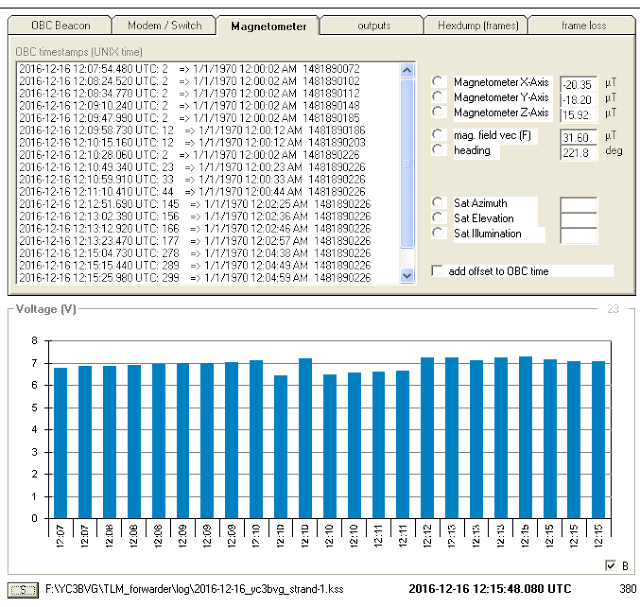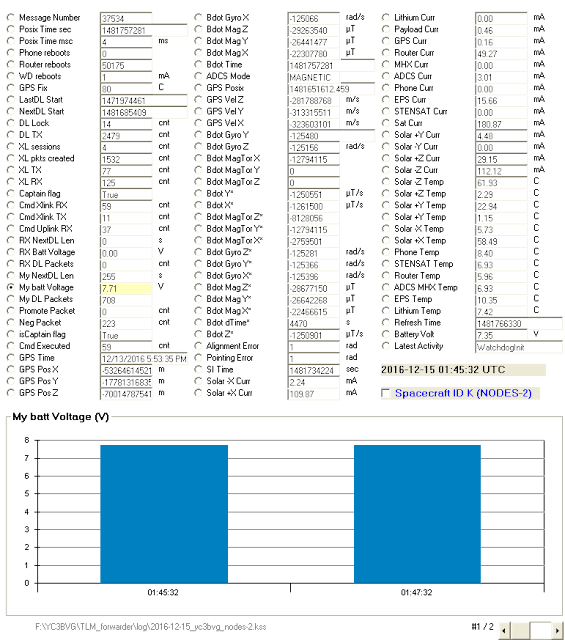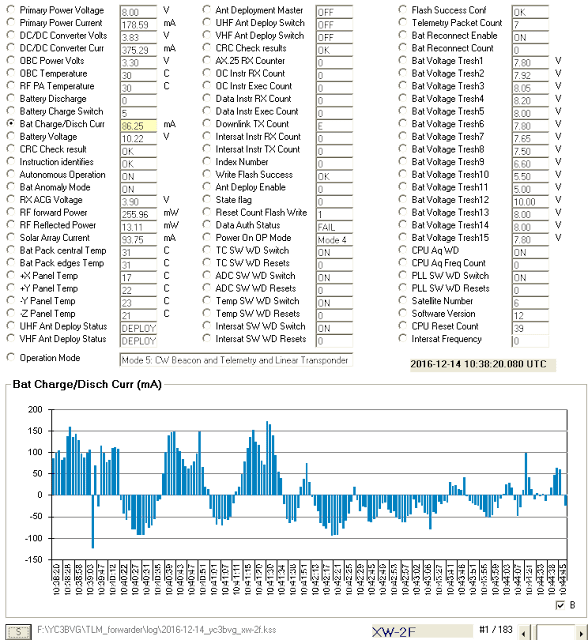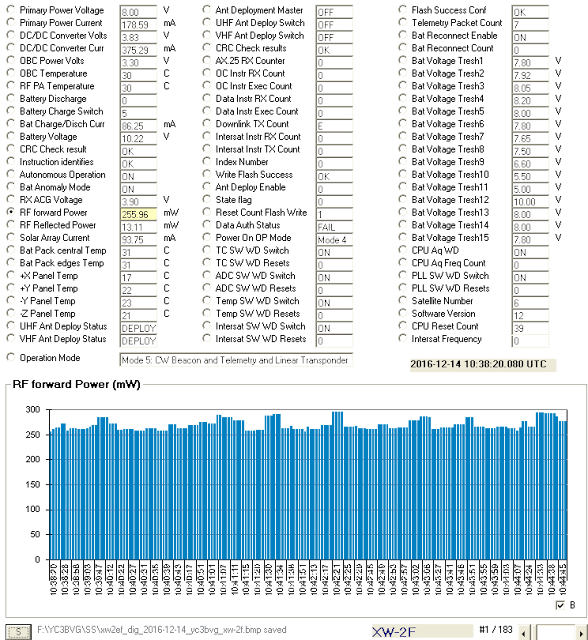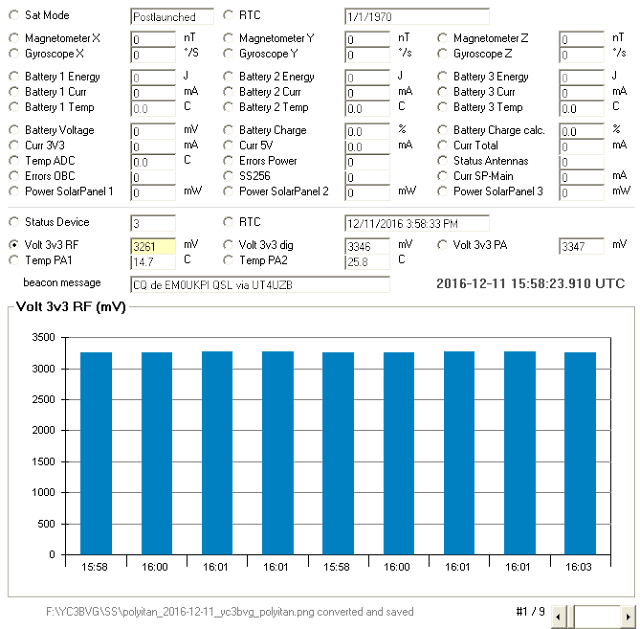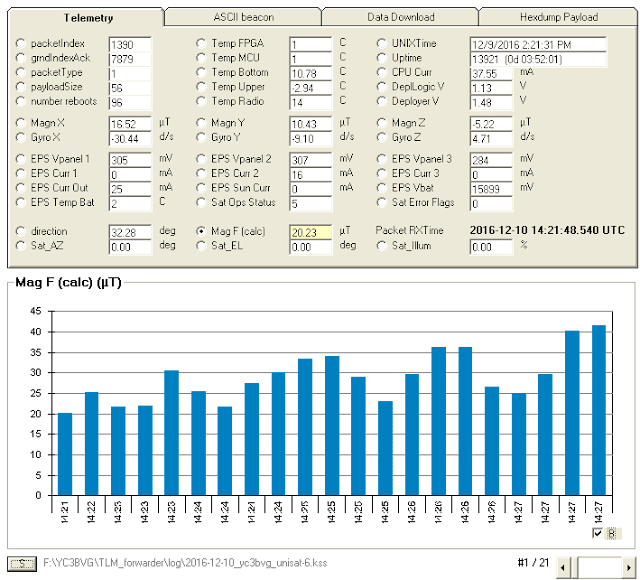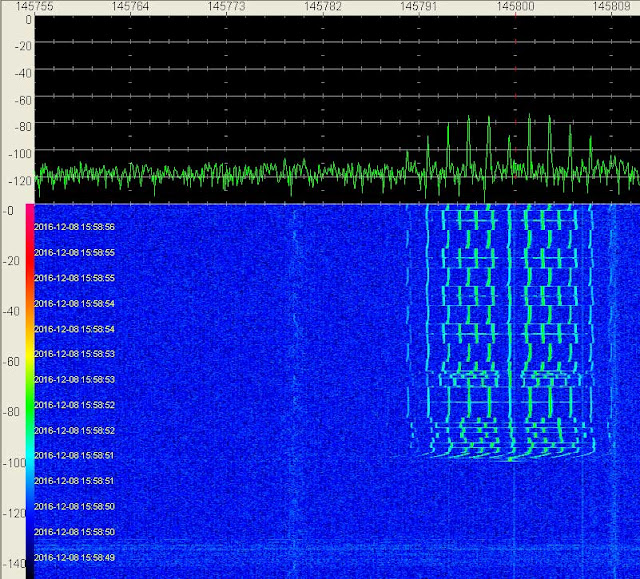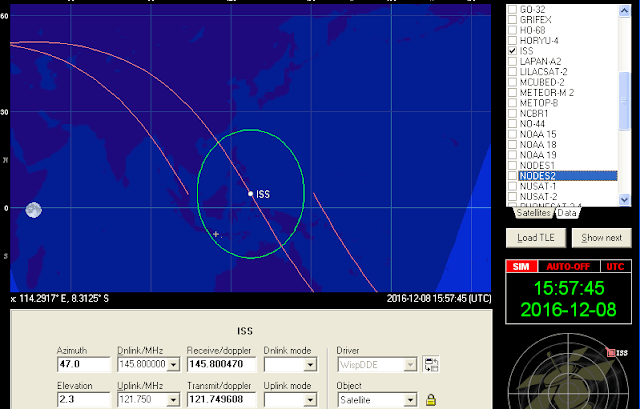
Home » Archives for December 2016
PSAT 1k2 AFSK Telemetry over Indonesia

Heard : Fm YD0NXX-1 To APOT30 Via PSAT*,WIDE2* <UI R Pid=F0 Len=46> [UTC:05:20:25R]
!0615.52S/10646.72E`50C Test igate untuk BARF
20161224053000 : PSAT]APRSON,ARISS,qAR,YC3BVG:!55 . S\013 . ES090/999/W3ADO s#024675,0z290
20161224053000 : PSAT]APRSON,ARISS,qAR,YC3BVG:s#024675,0z290,GcJ0fHgGMGFLBfIgDLGGLDfIh0JFGLEfJhbI
20161224052941 : PSAT]APRSON,ARISS,qAR,YC3BVG:T#920,861,069,788,785,401,00011000
20161224052840 : PSAT]APRSON,ARISS,qAR,YC3BVG:T#919,866,087,788,785,401,00011000
20161224052825 : PSAT]APRSON,ARISS,qAR,YC3BVG:s#024674,0z290,gcHeGKGEN0eGfFJGFNCfHgCIFGNEfGhaJDHM
20161224052824 : PSAT]APRSON,ARISS,qAR,YC3BVG:!55 . S\007 . ES090/999/W3ADO s#024674,0z290
20161224052739 : PSAT]APRSON,ARISS,qAR,YC3BVG:T#918,862,072,785,789,402,00011000
20161224052650 : PSAT]APRSON,ARISS,qAR,YC3BVG:s#024673,0z290,aELECNacIdEJEDNAdJdEIEENCdKeAIEFNDeK
20161224052649 : PSAT]APRSON,ARISS,qAR,YC3BVG:!55 . S\001 . WS090/999/W3ADO s#024673,0z290
20161224052638 : PSAT]APRSON,ARISS,qAR,YC3BVG:T#917,861,069,778,797,402,00011000
20161224052537 : PSAT]APRSON,ARISS,qAR,YC3BVG:T#916,871,069,778,805,402,00011000
20161224052436 : PSAT]APRSON,ARISS,qAR,YC3BVG:T#915,863,069,770,817,402,00011000
20161224052340 : PSAT]APRSON,ARISS,qAR,YC3BVG:s#024671,0z290,edKeEMEDM0dJeDMDEMBcJdBMDEMCcJd0LBEM
20161224052339 : PSAT]APRSON,ARISS,qAR,YC3BVG:!54 . S\013 . WS090/999/W3ADO s#024671,0z290
20161224052335 : PSAT]APRSON,ARISS,qAR,YC3BVG:T#914,865,072,763,824,403,00011000
20161224052234 : PSAT]APRSON,ARISS,qAR,YC3BVG:T#913,845,353,767,828,403,00011000
20161224052133 : PSAT]APRSON,ARISS,qAR,YC3BVG:T#912,855,069,764,834,403,00011000
Source : http://www.findu.com/cgi-bin/pcsat.cgi?absolute=1
PSAT Telemetry Decoder
Audio Record PRATHAM CW Beacon over Indonesia 13:48 UTC , December 18 2016
Audio Record PRATHAM CW Beacon over Indonesia pass 13:48 UTC , December 18 2016 .
Click PLAY on Right top button for play audio
Check this out on Chirbit
Beacon:
Frequency: 145.980 MHz
Modulation: CW
Words per minute: 30
Power Emitted: 0.2 W (23 dBm)
Frequency: 145.980 MHz
Modulation: CW
Words per minute: 30
Power Emitted: 0.2 W (23 dBm)
Telemetry: To be switched on only over India and Europe (France)
Frequency: 437.455 MHz
Modulation: FSK
Rate: 1200 bps
Power Emitted: 0.06 W (18 dBm)
Frequency: 437.455 MHz
Modulation: FSK
Rate: 1200 bps
Power Emitted: 0.06 W (18 dBm)
PRATHAM CW Beacon Signal at SpectraVue
Loop Cw beacon : PRATHAM IIT BOMBAY STUDENT SATELLITE VU2BUG
SSTV from Space Station, Strong signal max Elv 2.3 degree 15:57 UTC over Indonesia

Start signal transmission of SSTV on SpectraVue
Orbitron Tracking Software
Below is Image decoded with MMSSTV ,with max Elv 2.3 degree just got half of SSTV Image from International Space Station.
RESOURCESAT-2A Launch from PSLV-C36

In its thirty eighth flight (PSLV-C36), ISRO's Polar Satellite Launch Vehicle successfully launched the 1235 kg RESOURCESAT-2A Satellite today morning (December 07, 2016) from Satish Dhawan Space Centre SHAR, Sriharikota. This is the thirty seventh consecutively successful mission of PSLV.
Below is the TLE for RESOURCESAT-2A from Celestrak
RESOURCESAT-2A
1 41877U 16074A 16342.54919865 -.00000044 00000-0 00000+0 0 9996
2 41877 98.7293 54.5053 0011702 246.0912 220.1591 14.20787542 59:
RESOURCESAT-2A (India)
 Indian spacecraft is designed to meet the challenges of disaster prevention, land and water management.
Indian spacecraft is designed to meet the challenges of disaster prevention, land and water management.
Tasks:
creation and updating of topographical maps and special plans up to the scale 1:50 000;
update topographic underlying basis for the development of regional schemes of territorial planning projects;
control of forest management and monitoring of forests;
monitoring of the state of crops, yield forecasting.
monitoring of the ecological state of the territories;
monitoring and forecasting of swamping and desertification, salinization, karsts, erosion, wildfires
 Indian spacecraft is designed to meet the challenges of disaster prevention, land and water management.
Indian spacecraft is designed to meet the challenges of disaster prevention, land and water management.Tasks:
creation and updating of topographical maps and special plans up to the scale 1:50 000;
update topographic underlying basis for the development of regional schemes of territorial planning projects;
control of forest management and monitoring of forests;
monitoring of the state of crops, yield forecasting.
monitoring of the ecological state of the territories;
monitoring and forecasting of swamping and desertification, salinization, karsts, erosion, wildfires
IITMSAT (India)
 Indian nano-satellite weighing about 15 kg, the students created IIT Madras.
Indian nano-satellite weighing about 15 kg, the students created IIT Madras.
A small student satellites will orbit at 600-800 km start collecting data on the behavior of electrons and protons in the upper layers of the Earth's ionosphere.
One of the most interesting features of this mission is that it will expand on existing data to create an accurate earthquake prediction model based on ionospheric changes to seismic activity.
There is a theory that before the earthquake in the ionosphere undergo some changes, which in principle can be fixed. Now, using this theory and tools directly to fix the slightest changes in ionospheric Scientific Society of India will be able to collect good statistics and a large set of data, which in time will form the basis of earthquake prediction model.
The target hardware on board the spacecraft is a highly sensitive detector that is designed for measuring the fluctuations of protons and electrons flow in the upper ionosphere.
Reception frequency IITMSAT - 437.505 19k2 GMSK
 Indian nano-satellite weighing about 15 kg, the students created IIT Madras.
Indian nano-satellite weighing about 15 kg, the students created IIT Madras.A small student satellites will orbit at 600-800 km start collecting data on the behavior of electrons and protons in the upper layers of the Earth's ionosphere.
One of the most interesting features of this mission is that it will expand on existing data to create an accurate earthquake prediction model based on ionospheric changes to seismic activity.
There is a theory that before the earthquake in the ionosphere undergo some changes, which in principle can be fixed. Now, using this theory and tools directly to fix the slightest changes in ionospheric Scientific Society of India will be able to collect good statistics and a large set of data, which in time will form the basis of earthquake prediction model.
The target hardware on board the spacecraft is a highly sensitive detector that is designed for measuring the fluctuations of protons and electrons flow in the upper ionosphere.
Reception frequency IITMSAT - 437.505 19k2 GMSK
Max Valier (Italy)
 Max Valier Sat is a 15-pound X-ray laboratory, which has on board an additional payload in the form of the amateur radio communication system. The main participants in the cooperation project involved:
Max Valier Sat is a 15-pound X-ray laboratory, which has on board an additional payload in the form of the amateur radio communication system. The main participants in the cooperation project involved:
Max Planck Institute, who developed a small X-ray telescope μRosi, allowing amateur astronomers for the first time to observe the cosmos at X-rays.
OHB-System permits the launching of the spacecraft with the help of an Indian PSLV rocket.
Initially, the unit is also planned to install a system produced by LuxSpace receiving AIS signals and CMOS camera, but then this idea have decided to refuse. The machine is also equipped with a special camera that will allow the telescope to tie removable portion of the sky to an accuracy of 0.06 degrees.
Receiving Frequency Max Valier - 145.860 / 437.325 1k2,9k6, CW
 Max Valier Sat is a 15-pound X-ray laboratory, which has on board an additional payload in the form of the amateur radio communication system. The main participants in the cooperation project involved:
Max Valier Sat is a 15-pound X-ray laboratory, which has on board an additional payload in the form of the amateur radio communication system. The main participants in the cooperation project involved:Max Planck Institute, who developed a small X-ray telescope μRosi, allowing amateur astronomers for the first time to observe the cosmos at X-rays.
OHB-System permits the launching of the spacecraft with the help of an Indian PSLV rocket.
Initially, the unit is also planned to install a system produced by LuxSpace receiving AIS signals and CMOS camera, but then this idea have decided to refuse. The machine is also equipped with a special camera that will allow the telescope to tie removable portion of the sky to an accuracy of 0.06 degrees.
Receiving Frequency Max Valier - 145.860 / 437.325 1k2,9k6, CW
Venta-1 (Latvia, Germany)
 Venta 1 - the first Latvian satellite, which belongs to a class of nano-satellites. "1, Venta" receiver is equipped with an automatic identification system (AIS), which is designed to perform vessel traffic monitoring in Europe.
Venta 1 - the first Latvian satellite, which belongs to a class of nano-satellites. "1, Venta" receiver is equipped with an automatic identification system (AIS), which is designed to perform vessel traffic monitoring in Europe.
Spacecraft ", Venta 1" was created in Ventspils University College. All signals of "1, Venta" will be coming to the Ventspils International Radio Astronomy Centre. The cost of the satellite ", Venta 1" is 500 thousand. euros, most of which was financed by European investors.
As the main load on board Latvian satellite ", Venta 1" is set to the receiver "LuxSpace" the first generation to receive AIS signals. On ", Venta 1" satellite will be coming aboard the signals from large ships, which will indicate the parameters of their movement: speed, direction, position, etc.
Also on board ", Venta 1" will set a small camera and a laser reflector.
Reception frequency Venta-1 - 437.325 CW
 Venta 1 - the first Latvian satellite, which belongs to a class of nano-satellites. "1, Venta" receiver is equipped with an automatic identification system (AIS), which is designed to perform vessel traffic monitoring in Europe.
Venta 1 - the first Latvian satellite, which belongs to a class of nano-satellites. "1, Venta" receiver is equipped with an automatic identification system (AIS), which is designed to perform vessel traffic monitoring in Europe.Spacecraft ", Venta 1" was created in Ventspils University College. All signals of "1, Venta" will be coming to the Ventspils International Radio Astronomy Centre. The cost of the satellite ", Venta 1" is 500 thousand. euros, most of which was financed by European investors.
As the main load on board Latvian satellite ", Venta 1" is set to the receiver "LuxSpace" the first generation to receive AIS signals. On ", Venta 1" satellite will be coming aboard the signals from large ships, which will indicate the parameters of their movement: speed, direction, position, etc.
Also on board ", Venta 1" will set a small camera and a laser reflector.
Reception frequency Venta-1 - 437.325 CW
NIUSAT-Keralshree (India)
 NIUSAT is a spacecraft that was designed by the Indian Noorul Islam Centre for Higher Education, and is equipped with a sensor-strength, (MWiFS) to capture the Earth's surface in the interests of agriculture and assistance in nat
NIUSAT is a spacecraft that was designed by the Indian Noorul Islam Centre for Higher Education, and is equipped with a sensor-strength, (MWiFS) to capture the Earth's surface in the interests of agriculture and assistance in nat
 NIUSAT is a spacecraft that was designed by the Indian Noorul Islam Centre for Higher Education, and is equipped with a sensor-strength, (MWiFS) to capture the Earth's surface in the interests of agriculture and assistance in nat
NIUSAT is a spacecraft that was designed by the Indian Noorul Islam Centre for Higher Education, and is equipped with a sensor-strength, (MWiFS) to capture the Earth's surface in the interests of agriculture and assistance in nat
Subscribe to:
Comments (Atom)Template Responsive Design

































